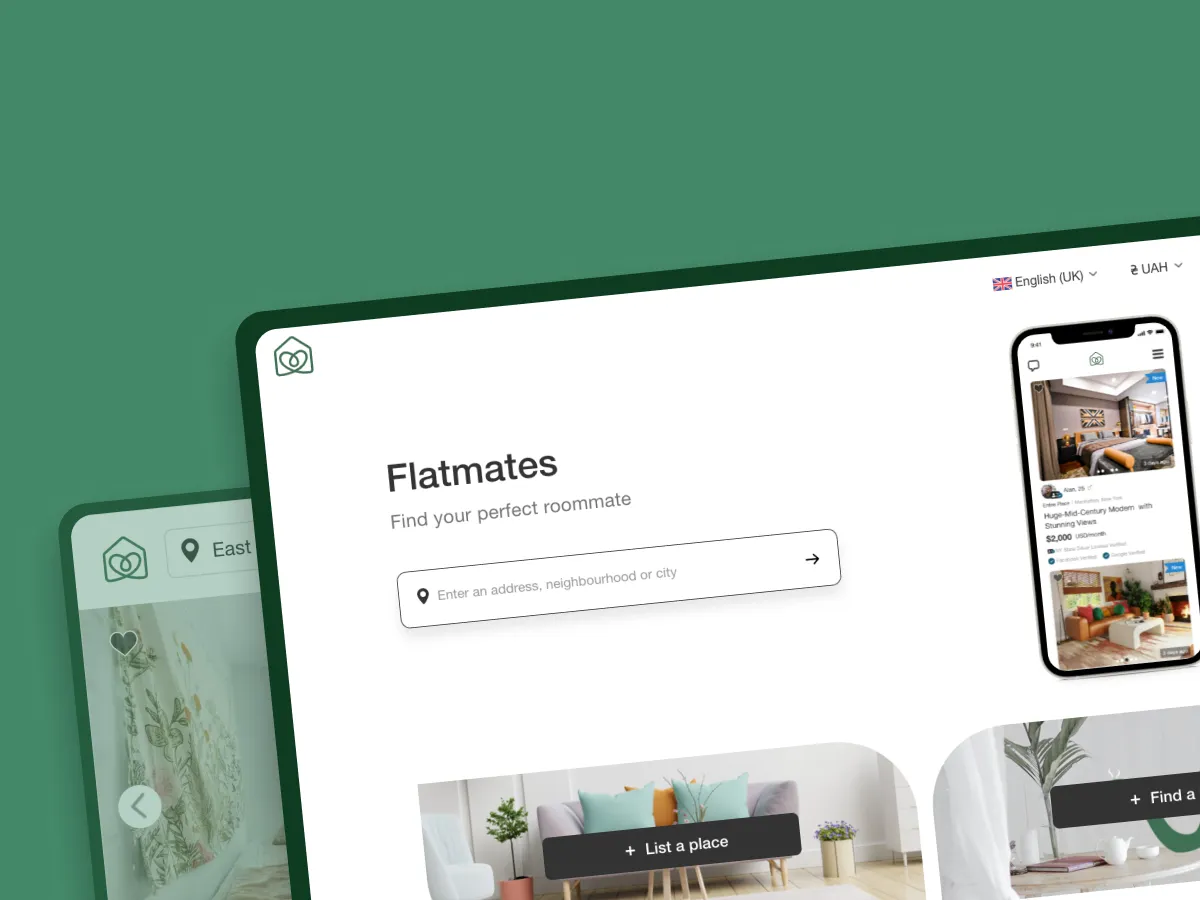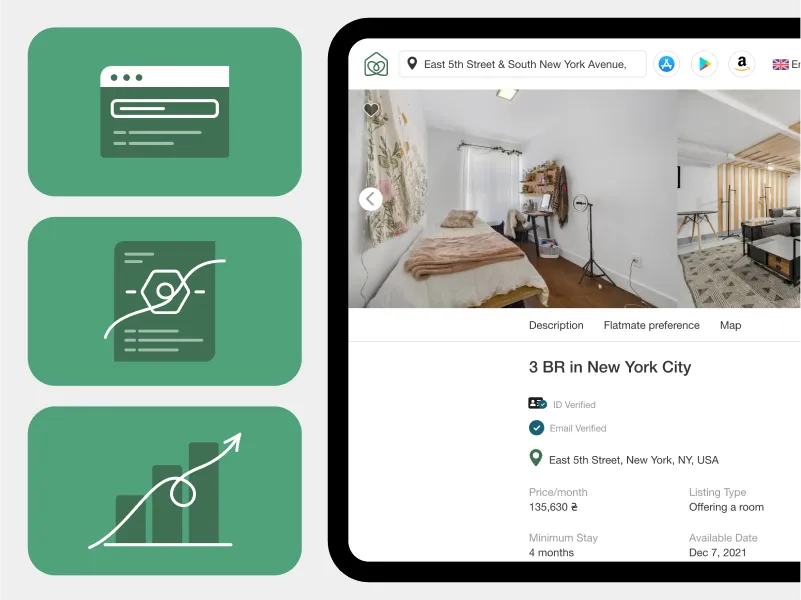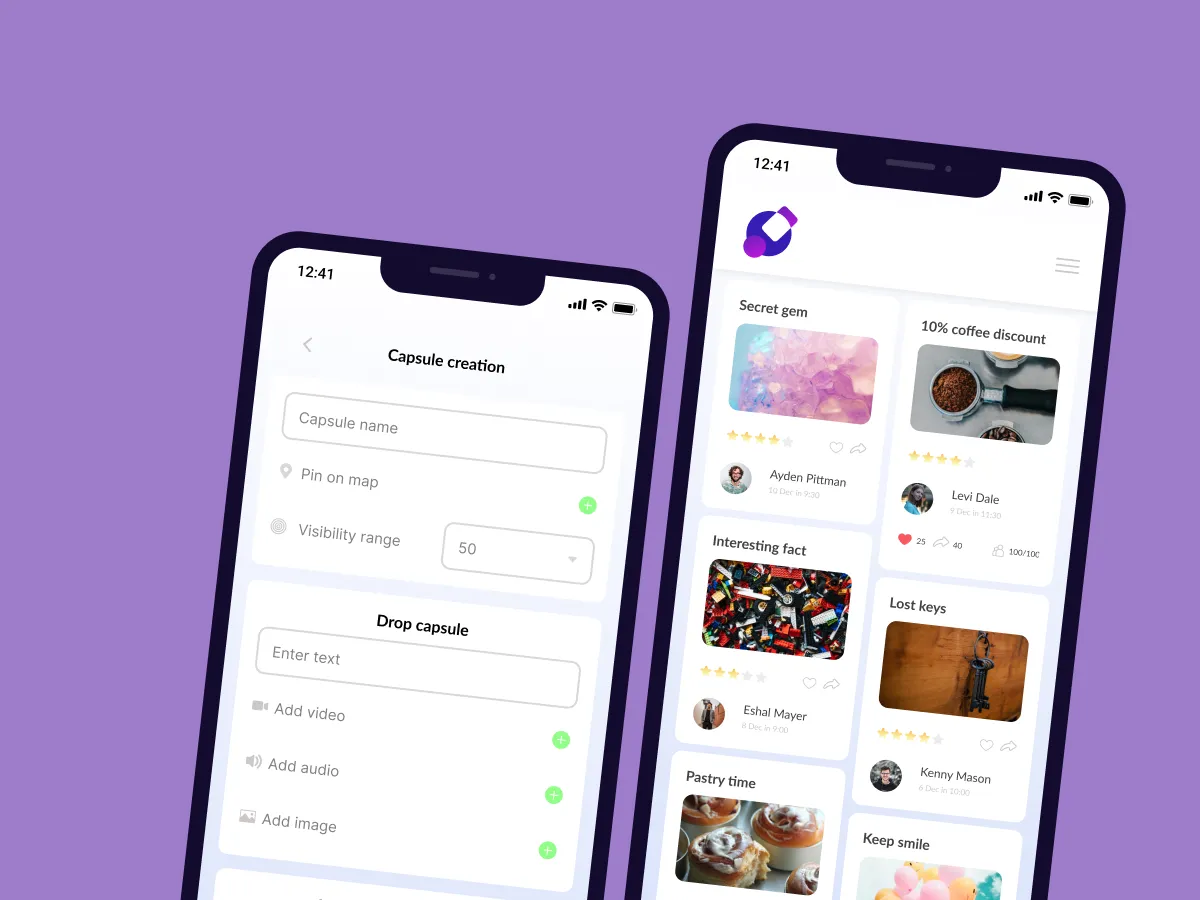Roomster: Biggest Roommate Finder Platform in USA

Industry
Real estate
Location
USA
Partnership period
2018 – Ongoing
Team size
10
Project information
Overview
Roomster is an Airbnb-like social platform for people around the world who are looking for roommates to live with. It has 5+ million active listings in different countries worldwide and 3+ million active users every month. It has a website built with .NET, Python, and ReactJS, as well as native mobile applications for iOS and Android.
About Client
The client is an international room rental company with headquarters in New York. The company was founded in September 2003 and has helped people look for accommodations and roommates around the world. Currently, it operates in 192 countries and supports 18 languages, providing 24/7 customer service.
Our Task
While working on the Roomster project, we managed to combine the efforts of our technical specialists and marketing team, which sets this project apart from many others. We have divided this case into the two aforementioned areas our specialists worked with for convenience.

Boost your online presence to drive growth?

Business First
Code Next
Let’s talk
Implementation
The team of software engineers and IT specialists have developed the online booking portal from scratch.

Requirements Analysis
Our team was tasked with thinking over and developing a fast yet flexible geospatial search using open-source location data. The use of Google Maps API was not possible. Moreover, the Roomster team wanted the user to be able to specify many different parameters when searching.

Data Schema Design
We created our internal city (state, block, room, etc.) IDs and mapped them to external ones (coming from Pelias). It allowed us to get rid of data duplication while interacting with the current API and with any other geocoder in the future.

Database Selection
We chose ElasticSearch, which was definitely the best choice for a high-load search. It allowed using both simple city IDs (just integers) and geopoints for fully-fledged geospatial search. By adding Kubernetes, as the most mature enterprise-ready orchestration system, our team managed to install the most configurable container orchestration system for microservices.

Solution Development
Choosing the right data schema, database engine and orchestration system allowed us to satisfy our client’s functional and non-functional requirements. Despite using an open-source service with messy data, we managed to build a flexible, scalable, and resilient search system.

Optimization
We have optimized the search flow so that it consisted of 3 main stages:
- The user enters freeform text in the search field.
- This action triggers an API call to the Pelias autocomplete API.
- The city ID is sent to our search API, which returns all apartments matching the ID.
Marketing input
A dedicated team of CodeIT marketing specialists supported the brand’s establishment and promotional efforts.
Challenges
Our marketing team faced the following challenges:
- Develop an effective marketing strategy
- Create an adequate and understandable advertising budget plan
- Optimize the landing pages
- Identify the main channels for attracting stable and relevant traffic
- Set up the link-building process
- Launch the promotion of mobile applications (iOS and Android)


Activities
After a series of consultations with the client, our marketing team has taken the following steps:
- Definition and analysis of the main competitors in the segment. (Services like Airbnb, Zillow, and Trulia were our markers).
- Updating the design of the main landing pages with a focus on the countries selected above (Custom texts for each of the languages and automated takeup of the newest listings from the relevant locations).
- Keyword clustering with the creation of a multilingual semantic core for the following countries: USA, UK, Germany, France, and Ireland.
- Website technical audit. (Using ScreamingFrog, Netpeak Spider, and SEO Site Checkup).
- Creation of a new advertising campaign and cross-linking strategy.
Result
A global roommate and room booking app
The fully-functional application enables users all over the world to find roommates and book rooms online in several clicks. Moreover, all the above-mentioned actions ensured a 2-fold increase in organic search traffic, without spending on link building. You can find Roomster on App Store & Google Play.
Hire a skilled team that will seamlessly integrate into your project

Business First
Code Next
Let’s talk
Services
- Web development
- Business Analysis
- iOS Development
- Android Development
- Quality Assurance
Team
- UI/UX designer
- Business Manager
- Project manager
- Marketing Specialists
- Front-End Developers
- iOS developer
- Android developer
- Back-End Developer
- QA Manual Engineers
- QA Automation Engineers
Technology stack
- React JS
- Redux
- Redux Saga (middleware)
- SSR (Next.js)
- @loadable/components
- Webpack
- REST API
- Websocket (socket.io)
- JEST
- Jsdoc
- Mapbox GL JS
- Dropzonejs
- I18next
- Kubernetes
- Amazon EKS
- RabbitMQ
- Python
- Flask
- SQLAlchemy
- Celery
- Android SDK
- Android Studio
- Android Support Library
- Java8
- RxJava for Android
- Swift 5 (5.1)
- UIKit
- Cocoa Touch SDK
- CoreData
- CocoaPods
- FLEX
- Crashlytics(Firebase)
- SwiftLint
- Fastlane
- Alamofire
- Eureka
- Kingfisher
- PromiseKit
- Branch.io
- Gitlab CI
- PostgreSQL+PostGIS
- GraphDB
- ElasticSearch
- MongoDB
- Cassandra
Related cases
Explore related services
Web Development
Build web apps that deliver a smooth and consistent experience on every device.
Mobile Development
Create mobile applications with custom features using the best-choice technology.
Architecture Consulting
Build an architecture that supports your business’s needs and long-term growth plans.
Quality Assurance
Ensure a flawless launch by running thorough testing before releasing your software.





